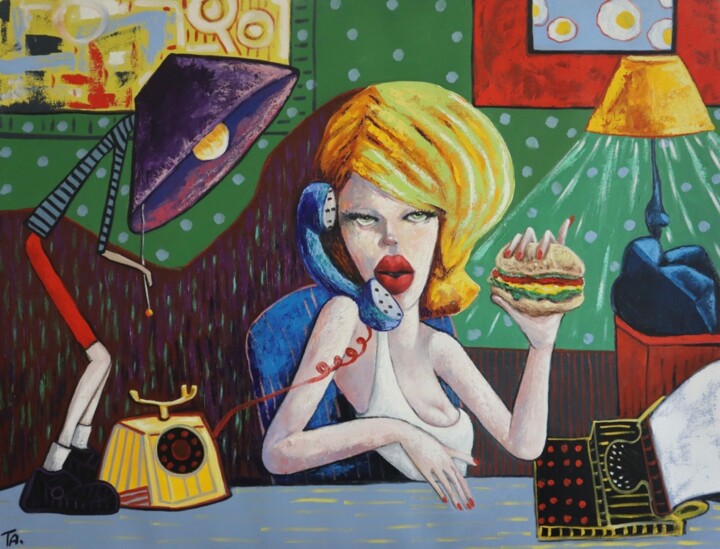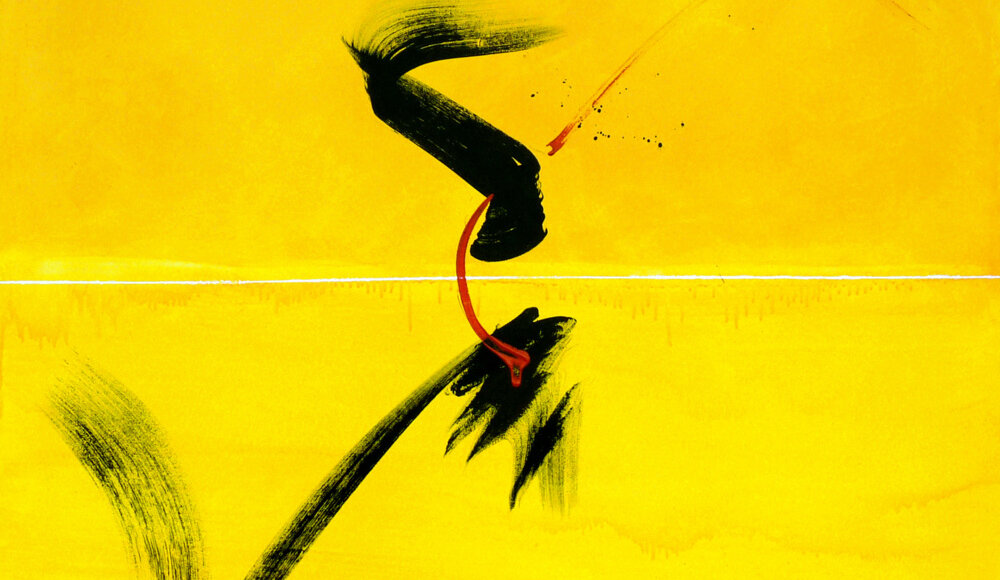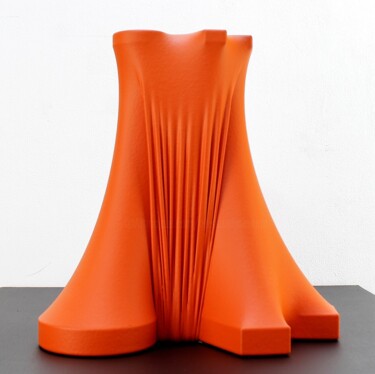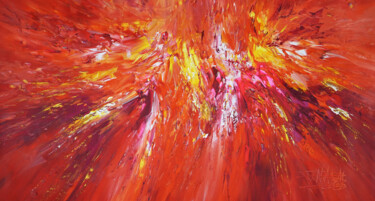Introduction to the Comparison
Warm and cool colors will be showcased within the narrative of art history, following two basic intentions: the first is to juxtapose classic masterpieces with contemporary works from Artmajeur, while the other consists of comparing two types of writing, one simple and descriptive, the other more lyrical, creative, imaginative, and emotional. To help you understand: I will begin by taking the example of red, analyzing Matisse's "The Red Room" through a clear, flowing, and obvious description, and then contrasting it, later on, with a text about a contemporary work of similar subject matter but with a more complex and articulated textual character. In this way, as we continue with other colors, I'm not just asking you to choose between new and old art subjects, but also to imagine expressing your preferences regarding the different ways in which interpretation can be approached. Let's get started!
 50 SHADES OF RED (2021)Painting by Ditim
50 SHADES OF RED (2021)Painting by Ditim
Warm colors
Red
Warm Colors Red "Harmony in Red" (1908) by Matisse
"Harmony in Red" by Henri Matisse captures a distinctive emotional and personal atmosphere by defying traditional figurative representations. Within the painting, a domestic worker carefully arranges fruit on a pedestal placed on a large table. Adjacent to this scene, a rustic straw chair faces a sizable canvas displaying a simplified landscape. In the foreground, a bush commands attention, while in the background, a meadow adorned with violet and golden blooms unfolds. Delicate, towering trees adorned with white flowers punctuate the landscape. The horizon, positioned notably high, delineates the sparse blue sky. Near the uppermost section, almost touching the left corner, a graceful pink cottage completes the composition.
"50 Shades of Red" by Ditim
We find ourselves once again indoors, but here, the act of arranging fruit replaces the quiet of rest, even of observational nature. In fact, there aren't many elements in the artwork that would move the viewer's gaze around, as all attention is captured by the sensuality of the protagonist with reddish skin. This passionate warm color, which also covers the floor viewed from above, is only interrupted by the black of the armchair and a few other details. It's in this environment described above that the model is caught in sleep, striking a sensual and studied pose, probably to attract attention, inviting those who cross the threshold of her house. The realistic stylistic features reinforce what has just been noted, along with the respect for perspective laws, which were lacking in the narrative of the French master, where everything appeared red and almost on the same plane. However, Matisse pursued a clear intent: to distance the viewer from real space and lead them into his own inner and emotional dimension. The spaces just mentioned, instead, are closely linked to the real world by Ditim's concrete eroticism, who admits: sensuality "spreads like molten iron over the painting, executed in fiery red tones. The hands gracefully resting on the armrest and the elegant long legs eloquently evoke grace, sensuality, and femininity. The woman is definitely aware of her natural magnetism and knows how to emphasize it, skillfully teasing without crossing the line. A deadly attribute in a woman's arsenal is a black dress that exposes a graceful neck under which fragile collarbones appear. The exposed areas of skin burn under fiery gazes but still leave room for the flight of imagination. Red is the color of fervent attraction, the color of vibrant and pulsating life. It is the embodiment of naked passion, synonymous with accelerated heartbeat and agonizing anticipation. It can ignite a fire with a glance, warm the heart. The painting strikes with its aura that harmoniously fits into interiors, indiscreetly attracting attention thanks to its spicy romanticism and sharpness." Finally, after associating red with the life of indoor environments, we move on to the one that involves orange and the female figure observed more closely.
 MUSICIAN, 2020 (2020)Painting by Natasha Kiryushkina
MUSICIAN, 2020 (2020)Painting by Natasha Kiryushkina
Orange
"Flaming June" (1895) by Frederic Leighton
In the artwork, we see a woman peacefully sleeping on a marble bench, with the sea in the background reflecting the sunset. She wears a semi-transparent orange dress, which reveals the contours of her body to the observer. A faint blush on her cheeks suggests a subconscious awareness of being observed, even in her sleep. Perhaps, the branch of toxic oleander positioned in the upper right corner symbolizes the delicate link between sleep and mortality.
"Musician" by Natasha Kiryushkina
Orange transcends the boundaries of clothing to overflow onto the background of the artwork and partly onto the nuances of the skin of the portrayed woman, in this case awake but perhaps unaware of being watched, as the weight of her thoughts leads her gaze elsewhere, far from the viewer and perhaps even farther from being understood or intuited. Melancholy can, however, be shared with the model, just by remembering for a moment what usually prompts us to feel that sentiment, summoning it to sing us a haunting lullaby of stifled anguish in our minds. To all this, a slow melody can be associated, one that perhaps the title of the realistic painting from Artmajeur's artist suggests, which can also alternate with the silence brought by the tragic arrival of unresolved ugly thoughts or the compulsive and pounding sound of the flow of continuous torments. Finally, regarding the context in which "Musician" was executed, it seems to be an interior, where, unlike "Flaming June", one cannot gaze into distant horizons, so our eyes will remain trapped in the melancholic sonata of a monochromatic orange. Now, after the orange-female figure association, let's move on to the yellow-abstract surrealism!
 2011-YELLOW-2-ACRYLIQUE SUR TOILE-130 CM X 130 CM (2011)Painting by Corine Sylvia Congiu
2011-YELLOW-2-ACRYLIQUE SUR TOILE-130 CM X 130 CM (2011)Painting by Corine Sylvia Congiu
Yellow
"The Gold of the Azure" (1967) by Joan Miró
Miró's artwork is composed of a combination of organic shapes and symbols. Various oval-shaped areas, in both black and colors, adorn the canvas. These elements are set against a backdrop of vibrant yellow, with some symbols overlapping with both the background and the blue oval region.
"Yellow 2" by Corine Sylvia Congiu
Setting aside the discussion of oval shapes to focus on the background color, as well as the presence of organic forms or symbols, we can describe Corine Sylvia Congiu's work in a similar manner, aligning it with the Surrealist vein that ranges from abstraction to figurativism. Much like Miró, it offers a tool ready to evoke the unconscious, as well as the desire and freedom of expression. In the fantastical universe where the styles of the Catalan artist and the Artmajeur artist meet, one can read the figure of hybrid forms, sometimes designed to vaguely recall some aspect actually found on earth. Everything is carefully crafted on the pictorial support, eschewing randomness to be organized in careful compositional balance, where background, shapes, symbols, allusions to reality, and colors harmoniously express themselves. Finally, other aspects that unite the two works are the ability of the yellow background to condition the entire composition, upon which the signs overlap, respecting a two-dimensional spatial conception organized by the same elements that compose it. Now it's time for the cool colors, where blue stands out in works where it appears as a fundamental accessory!
 “VIRGINITY” (2016)Photography by Diako Art
“VIRGINITY” (2016)Photography by Diako Art
Cold Colors
Blue
"Virgin Annunciate" (1475) by Antonello da Messina
In the painting, Mary is depicted at the moment when she faces an imaginary interlocutor, her right hand appearing to hold him back; the silhouette of her cloak reveals the flawless oval of the Virgin's face. The composition finds a focal point in the fold of the blue cloak, running from the forehead down to the corner of the lectern, perhaps arbitrarily placed, while the subtle turn of Mary's figure and her hand gesture lend a sense of naturalness to the scene. Some interpretations discern various narrative moments within the expressive details of Mary's hands, gaze, and lips.
"Virginity" by Diako art
We can imagine a new work by Antonello, in which the blue mantle extends by exaggeration, covering the background and the protagonist, revealing only part of her bust and her gaze, which remain mysterious in posture and intent. Nevertheless, the eyes, in the visible part, seem to scrutinize something or someone suspiciously, probably any figure about to arrive, whose presence is decidedly unwelcome. This detail brings us back to what was described in the masterpiece above, where, with the similar intention of repelling, a hand had even been raised, but who can say then that the same does not happen in "Virginity"? It would indeed seem possible, although attributable to decidedly different narrative expedients, as the Artmajeur artist draws inspiration not from the recounting of sacred texts but from the multiple difficulties that women face in their lives, confronting interdictions, suppressions, constraints, and violence, which condemn them to manifest their presence only in the part where it is allowed to them, and in this case, only with a glance. Now let's move on to the green and purple of the clothing of some characters in portraits, religious scenes, and genre scenes!
 "NORTH AND SOUTH. NEW REALITY " SERIES CONNECTIONS (2015)Painting by Yaroslav Kurbanov
"NORTH AND SOUTH. NEW REALITY " SERIES CONNECTIONS (2015)Painting by Yaroslav Kurbanov
Green
"Arnolfini Portrait " (1434) by Jan van Eyck
The depicted scene unfolds within the bridal chamber: a couple, adorned in opulent attire, stands before us. The stern-looking man gestures, a gesture open to interpretation as either a blessing or a greeting, while the woman, visibly pregnant, extends her hand to her husband, her other hand tenderly caressing her swollen belly. The Arnolfini spouses assume a solemn and dignified stance, likely reflecting the gravity of the occasion: this portrait was probably commissioned to commemorate their marriage, demanding a certain gravitas in their expressions. Jan van Eyck meticulously captures the details of the surroundings, accurately rendering every object within the room.
"North and South - New Reality" by Yaroslav Kurbanov
Green is the protagonist of the masterpiece described above, which, together with its complementary red, manages to enliven, increasing the compositional impact, both the volumes and the depth of the spaces in the artwork. In doing so, it naturally leads our attention more to the right side of the pictorial support, where it is positioned precisely on the garments of the pregnant woman. We can take what has been described so far and compare it with the work of the Artmajeur artist: also a double portrait. "North and South," using the perspective of the close-up, frames only the faces of two figures, enlivened again by the presence of green and its complementary. The first of these appears once again in what is the clothing, taking shape in the colorful hat ready to enliven the right side of the composition, which again appears chromatically more captivating, lively, rich, and more caught by the observer's eye.
 HELLO, HOW CAN I HELP? (2024)Painting by Ta Byrne
HELLO, HOW CAN I HELP? (2024)Painting by Ta Byrne
Purple
"The Resurrection of Christ" by Raphael (1501-2)
Emerging from a tomb of classical style, Jesus ascends. He stands upon a light cloud, holding a crusader flag in his left hand while extending a blessing with his right hand, forming the Trinitarian sign. His figure, naked except for a large red cloak enveloping his body, leaves his chest bare. Above his head rests a delicate halo, and his face is beardless, with his hair flowing in length. At the periphery, soldiers lie prone on both sides. One rests on a shield, his head adorned with a tight turban, while his counterpart wields a sword suspended at his hip and raises his arm towards the risen Christ. In the background, another figure gazes upwards, dressed in armor, helmet, and tight-fitting garments, armed with shield and spear. Foreground scenes show a snake slithering towards a soldier on the left, while a heron hovers near the water's edge on the right. The Madonna and two devout women traverse a path descending from a hill, flanked by a winding river and framed by slender trees. Sunlight emerges from behind the central hill, casting a luminous glow. Flanking Christ are two angels hovering, enveloped in billowing robes, one of which is purple.
"Hello, How Can I Help" by Ta Byrne
From sacred purple, we move to secular purple, aimed at animating the color of the top part of an anthropomorphic lamp, which, similar to the angel, is positioned beside the main subject of the pictorial narrative: a blonde woman depicted in an interior. "The other angel," this time dressed in yellow, would be the second luminous light, instead placed on the right side of Ta Byrne's support. The two winged beings from the Gospels and the New Testament accompany the revelation of Christ's immortality, while the light of the lamps in "Hello, How Can I Help" highlights the sometimes overwhelming dance of everyday life, leading us to reflect on both the potential of that frenetic energy and the quieter moments, of a reflective, introspective, and revealing nature that are inherent in it as well. Finally, regarding her painting, Ta Byrne herself adds: "I tried to capture the chaotic beauty of modern multitasking, the sleight of hand of technology, indulgence, and the constant call of duty." So I conclude by thinking about how the omnipresence of the divine narrative of Raphael's time is now replaced by frequent reference to our compulsive, devouring, fast, and omnipresent system, illuminated, and thus made understandable, by Ta's purple lamp, once a revealing angel of the divine word.


 Olimpia Gaia Martinelli
Olimpia Gaia Martinelli















































